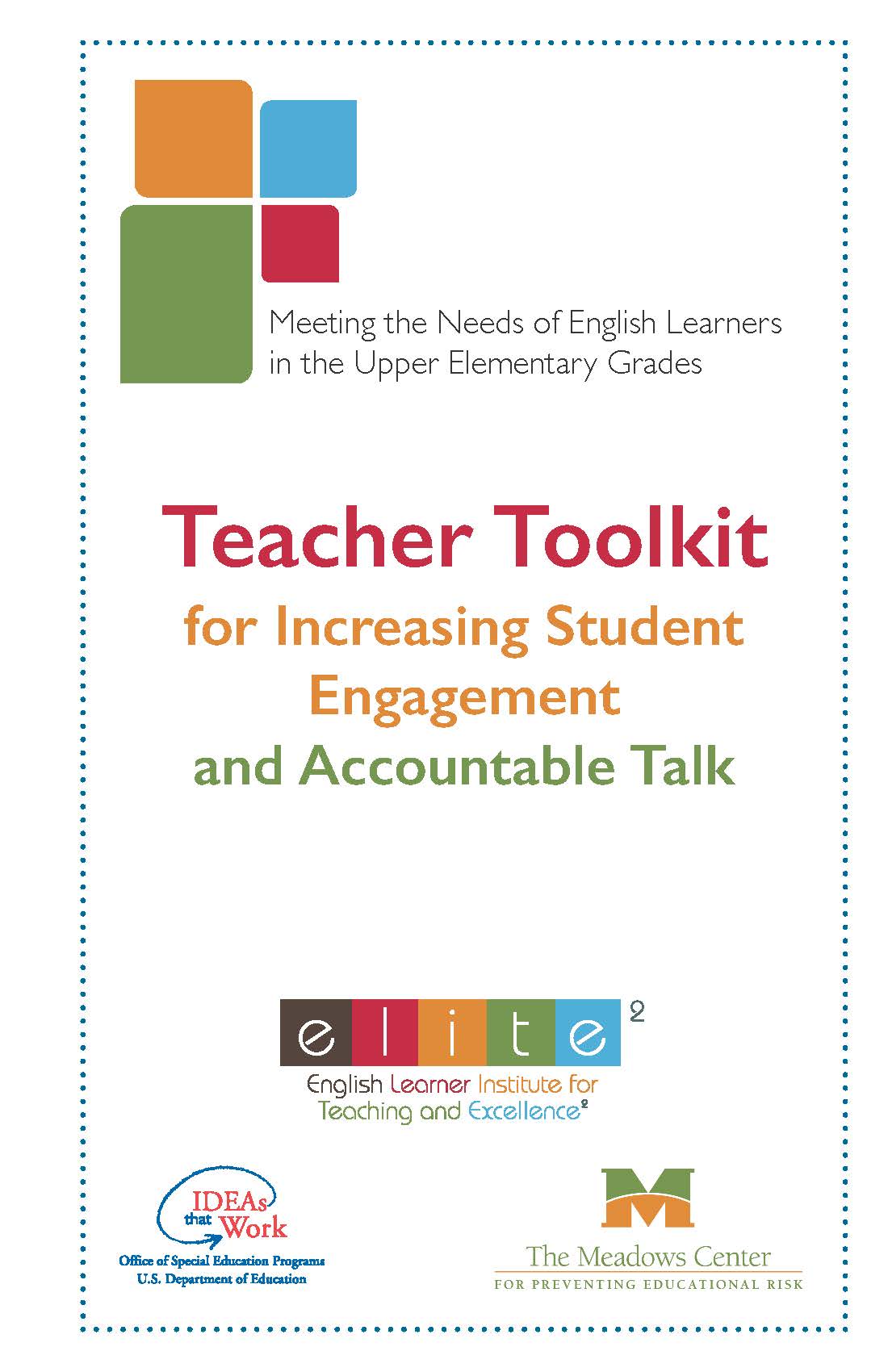Text Talks: A Strategic Book Club Routine for Building Vocabulary and Comprehension Skills

In collaboration with the practicing professionals at our partnering schools, Project ELITE2 developed and refined an instructional model that educators use to enhance core language and literacy instruction for students in grades 3-5. As part of this instructional system, teachers strategically set reading groups of 4-5 students, select relevant texts that are appropriate for their reading and language proficiency levels, and then divide the text into chunks. Before students read independently, teachers deliver a focused mini-lesson that includes previewing the text as well as explicitly teaching academic vocabulary concepts and reading comprehension processes. While students read independently, they practice word-learning strategies and record the meaning of new words. Students compose a written summary of the reading and respond to prompts in their journals to prepare for their group discussions. Next, students engage in structured, text-based discussion to advance their comprehension of the text and practice academic language.
Sample Materials
For more information, please contact a member of our team.
MTSS for ELs: Practice Guides

MTSS in the Early-Elementary Grades (K–2), Practice Guides
- Effective Practices for English Learners
- Assessment and Data-Based Decision-Making
- Core and Supplemental English as a Second Language Literacy Instruction
- Core and Supplemental Biliteracy Instruction
- Professional Development to Support a Multitiered Instructional Framework
MTSS in the Upper-Elementary Grades (Grades 3–5), Practice Guides
- Multitiered Instructional Systems for ELs
- Evidence-Based Tier 2 Intervention Practices for English Learners
- English Learners With Significant Learning Difficulties or Disabilities: Recommendations for Practice
- Fostering Collaborative Partnerships with Families of English Learners within a Multitiered System of Supports
- Promoting Leadership and Collaboration for an Effective Multitiered System of Supports for English Learners
Language and Literacy Instruction for ELs

Project ELITE2 supports educators in implementing best instructional practices for bilingual students and those learning English as a second language. Teachers develop their knowledge of the second language acquisition process, linguistically responsive pedagogy, and effective practices in native- and second-language literacy development. Educators are guided through formal professional development sessions, with ongoing support in applying new knowledge to their teaching practice. This page will be updated on an ongoing basis as trainings and resources are available to educators.
K-3 Educators can review several resources in the section Enhancing Vocabulary and Comprehension for English Learners through and Interactive Read-Aloud System.
Teacher Toolkit for Increasing Student Engagement and Accountable Talk
English learners benefit from high-quality, meaningful opportunities to use and practice the language(s) they are learning during literacy and content instruction. Project ELITE2 designed and collaboratively developed this toolkit and implementation guide with teachers with the goal of enhancing instruction to advance students’ academic language development through low-risk response, feedback, and assessment techniques. It was designed to guide teachers’ use of the various tools presented as part of the “Increasing Student Engagement and Accountable Talk” teacher training. This resource offers practical guidance for implementing the tools systematically.

Professional Development: Increasing Student Engagement and Accountable Talk
Professional Development: Understanding Second Language Development & Implications for Practice
Enhancing Vocabulary and Comprehension for English Learners Through an Interactive Read-Aloud System
The Read-Aloud Routine for Building Vocabulary and Comprehension Skills tools guide prekindergarten and K–3 educators in implementing a system for whole-class text reading focused on language and comprehension development for English learners (Giroir, Grimaldo, Vaughn, & Roberts, 2015; Hickman, Pollard-Durodola, & Vaughn, 2004). The key steps of the read-aloud routine include (1) introducing high-utility words within the context of a narrative or informational text (vocabulary, background knowledge); (2) reading the text aloud with students (modeling fluency); and then (3) structuring meaningful interactive, text-based activities that allow for deeper processing of new vocabulary and concepts from the text (vocabulary, comprehension, language development). The read-aloud system incorporates principles of culturally responsive pedagogy by providing guidance to teachers in choosing culturally responsive reading texts and facilitates vocabulary development by connecting new linguistic concepts to students’ backgrounds and lived experiences.
Getting Started With the Read-Aloud: Prekindergarten and K–3 Materials for Teachers
Sample Lessons and Video Models
20 English Lesson Plan Sets:
- The Story of Ruby Bridges
- Stellaluna
- Spoken Memories
- Painted Words
- Sitti’s Secret
- The Other Side
- One City, One School, Many Foods
- The Name Jar
- Lilly’s Purple Plastic Purse
- The Kissing Hand
- Julius, the Baby of the World
- Chrysanthemum
- Anansi and the Moss-Covered Rock
- In my Family
- I love Saturdays and Domingos
- A Chair for my Mother
- A Bad Case of the Stripes
- Corduroy
- Abuelo and the Three Bears
- Alexander and the Terrible, Horrible, No Good, Very Bad Day
9 Spanish Lesson Plan sets:
- Abuelo y los Tres Osos
- Alexander y el Día Terrible, Horrible, Espantoso, y Horroso
- Un Sillón para Mi Mamá
- Corduroy
- Stelaluna
- Me encantan los Saturdays y Domingos
- En Mi Familia
Videos:
If video files do not download, try right-clicking on the title and choose "Save Link As..."
Professional Development for K–3 Teachers
- Read-Aloud Presentation
- Reading Teacher article
- Abuelo Vocabulary, English
- Abuelo Lesson Plan
- Read-Aloud Observation Form
- Read-Aloud Routine Planning Template
Professional Development for Prekindergarten Teachers
- Prekindergarten Presentation “The Kissing Hand”
- Kissing Hand Participant Notes
- Kissing Hand Presenter Notes
- Vocabulary Card Template
- Kissing Hand Handouts
- Prekindergarten Presentation “Corduroy”
- Corduroy Participant Notes
- Corduroy Presenter Notes
- Corduroy Handouts
Creating Culturally Responsive Classrooms

Project ELITE2 delivered professional development on creating culturally responsive classrooms. Participants were introduced to the concept of “cultural responsiveness” and engaged in a small-group activity to record various ways to operationalize culturally responsive practices in the classroom. The PowerPoint presentation and handouts used during the session are available for download.
Implementing Structured Data Meetings for English Learners

Project ELITE2 developed professional development and tools to support Del Valle Independent School District in implementing structured data meetings at key assessment points throughout the year (the beginning, middle, and end of the year) for all educators serving English learners and monthly for core (Tier I) classroom teachers. The materials include guides and protocols for leading successful meetings and for documenting decisions about students and instructional planning. Self-paced training modules were also designed and used by educators to develop their understanding of the purpose of structured data meetings in a multitiered instructional framework. The training includes an overview of the purposes, procedures, and materials needed to conduct successful structured data meetings.
- Implementing Structured Data Meetings Handbook
- Beginning-of-Year Training and Materials
- Middle-of-Year Training and Materials
- End-of-Year Training and Materials
- Monthly Tier I Meetings
- Forms and Worksheets
Family and Community

Project ELITE2 developed a bookmark that presents a routine for parents to use with their children, based on the K–3 read-aloud system that is concurrently being implemented during students’ core classroom instruction. The parent and family guide is similar to the steps designed for teacher-led text reading but is modified for a simple and fun way to support literacy and family bonding through book reading. The bookmark guides parents in teaching children new vocabulary words and interacting with children during reading time to support language and comprehension development. The bookmark and training presentation are available in both English and Spanish.
Enhancing Vocabulary and Comprehension for English Learners Through an Interactive Read-Aloud System
The Read-Aloud Routine for Building Vocabulary and Comprehension Skills tools guide prekindergarten and K–3 educators in implementing a system for whole-class text reading focused on language and comprehension development for English learners (Giroir, Grimaldo, Vaughn, & Roberts, 2015; Hickman, Pollard-Durodola, & Vaughn, 2004). The key steps of the read-aloud routine include (1) introducing high-utility words within the context of a narrative or informational text (vocabulary, background knowledge); (2) reading the text aloud with students (modeling fluency); and then (3) structuring meaningful interactive, text-based activities that allow for deeper processing of new vocabulary and concepts from the text (vocabulary, comprehension, language development). The read-aloud system incorporates principles of culturally responsive pedagogy by providing guidance to teachers in choosing culturally responsive reading texts and facilitates vocabulary development by connecting new linguistic concepts to students’ backgrounds and lived experiences.
Sample Materials
For more information, please contact a member of our team.
Implementing a Multitiered System of Support for English Learners

Project ELITE2 developed two Implementation Manuals that provide guidance for future replicators, which may include district leaders, educators, and other stakeholders interested in implementing a multitiered system of supports (MTSS) model for English learners (ELs) in the primary grades (K–3) and the upper-elementary grades (3–5). The manuals include a description of the model and how it was developed, tested, and adapted; key personnel necessary to support the model; professional development required to implement the model; resources necessary for coordination; and strategies for implementing and sustaining the model over time. Formative and summative evaluation measures are also included. The manuals also describe all project-designed tools and deliverables, including a complete roster of the available professional development training and the instructional guides required for implementation, support, and sustainment.
This resource section also includes the Project ELITE Report, 2012–2015. This report discusses the development, refinement, and implementation of the multitiered model, along with a description of model practices and project tools used during implementation. We also provide a summary of project findings and an overview of dissemination.
Additionally, Cohort 5 of the Model Demonstration Coordination Center developed a Practice Brief Series on implementing effective multitiered instructional frameworks for ELs. The goal of this series is to assist administrators, educators, policymakers, and other stakeholders in implementing or refining a campuswide model for improving the academic achievement of ELs. The practice briefs address key issues in model implementation for ELs, such as assessment and data-based decision-making, effective core instruction and interventions for ELs, and professional development to support an MTSS framework for ELs.
- Grades 3–5 Implementation Manual
- Grades K–3 Implementation Manual
- 2021 Project Report
- 2015 Project Report
- MTSS for ELs: Practice Brief Series
- U.S. Department of Education Briefing: PowerPoint Presentation


